Deep learning is a subset of machine learning where artificial neural networks, algorithms inspired by the human brain, learn from large amounts of data.
Deep learning allows machines to solve complex problems even when using a data set that is very diverse, unstructured and inter-connected.
Deep Learning uses a Neural Network to imitate animal intelligence. There are three types of layers of neurons in a neural network: the Input Layer, the Hidden Layer(s), and the Output Layer.
Neurons apply an Activation Function on the data to “standardize” the output coming out of the neuron.

Deep learning is a class of machine learning algorithms that uses multiple layers to progressively extract higher-level features from the raw input. For example, in image processing, lower layers may identify edges, while higher layers may identify the concepts relevant to a human such as digits or letters or faces.
Deep-learning architectures such as deep neural networks, deep belief networks, recurrent neural networks and convolutional neural networks have been applied to fields including computer vision, machine vision, speech recognition, natural language processing, audio recognition, social network filtering, machine translation, bioinformatics, drug design, medical image analysis, material inspection and board game programs, where they have produced results comparable to and in some cases surpassing human expert performance.
Artificial neural networks (ANNs) were inspired by information processing and distributed communication nodes in biological systems. ANNs have various differences from biological brains. Specifically, neural networks tend to be static and symbolic, while the biological brain of most living organisms is dynamic (plastic) and analog.
The adjective “deep” in deep learning comes from the use of multiple layers in the network. Early work showed that a linear perceptron cannot be a universal classifier, and then that a network with a nonpolynomial activation function with one hidden layer of unbounded width can on the other hand so be.
Deep learning is a modern variation which is concerned with an unbounded number of layers of bounded size, which permits practical application and optimized implementation, while retaining theoretical universality under mild conditions. In deep learning the layers are also permitted to be heterogeneous and to deviate widely from biologically informed connectionist models, for the sake of efficiency, trainability and understandability, whence the “structured” part.
Useful URLS :
www.nvidia.com/en-us/deep-learning-ai/industries/robotics/ Learn More
www.nvidia.com/en-us/design-visualization/omniverse/ Download Isaac
SDK: www.developer.nvidia.com/isaac-sdk
